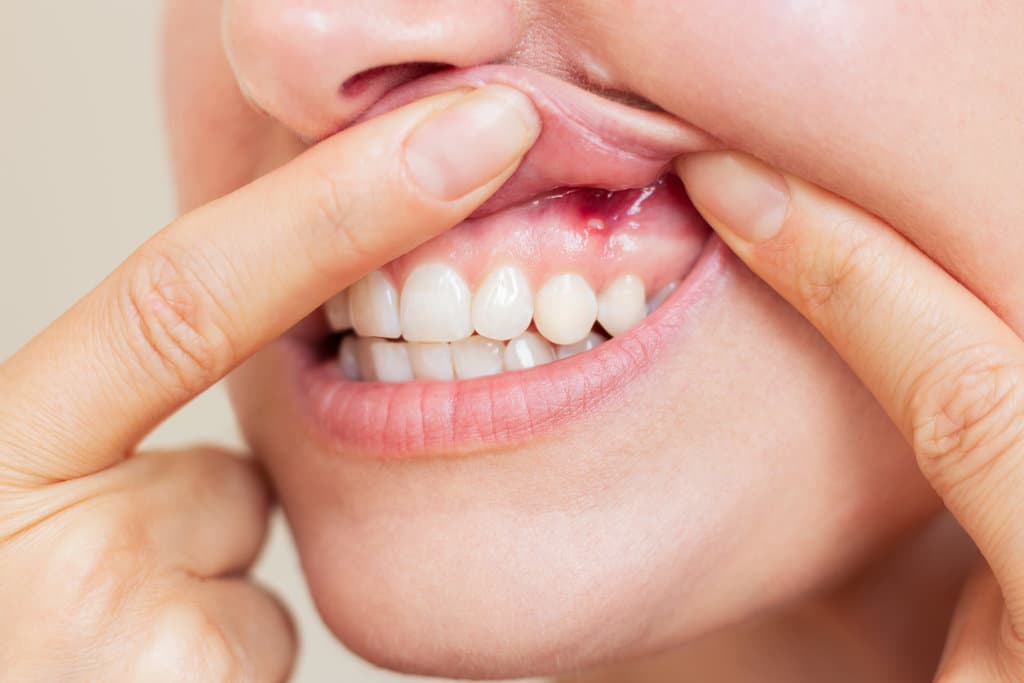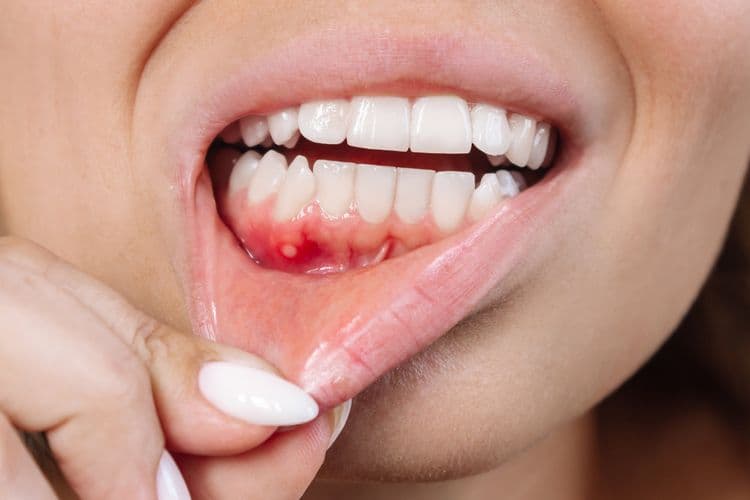Ulcers on the gums, or gingival ulcers, present as painful lesions that disrupt oral comfort and function. These sores can arise due to inadequate oral hygiene, dietary deficiencies, or psychological stress. Clinically characterized by round sores, they may appear white or yellowish. Effective management necessitates understanding etiology, symptoms, and available therapeutic interventions. The complexity of these lesions invites further exploration into targeted treatment and prevention strategies.
Understanding Gum Ulcers
Gum ulcers, clinically known as oral mucosal ulcers, are localized lesions on the gingival tissue characterized by a disruption of the mucous membrane. These lesions can greatly impact gum health, leading to discomfort and potential complications if not addressed. Effective oral care is pivotal in managing these ulcers. Research underscores the importance of maintaining ideal oral hygiene to prevent secondary infections, which can exacerbate symptoms. Current treatment modalities for gum ulcers focus on promoting healing and reducing pain. These include topical antiseptics, analgesics, and, in some cases, corticosteroids to manage inflammation. Adjunctive therapies may involve the use of antimicrobial mouth rinses to enhance oral care. Regular dental check-ups are recommended to monitor gum health and to prevent recurrence of these lesions.
Common Causes of Gum Ulcers
Gum ulcers often result from inadequate oral hygiene, which allows for bacterial overgrowth and subsequent tissue damage. Evidence suggests that nutritional deficiencies, particularly in vitamins such as B12 and C, can compromise mucosal integrity and increase susceptibility to ulceration. Addressing these causes involves implementing rigorous oral hygiene practices and ensuring a balanced diet to promote ideal oral health.
Oral Hygiene Neglect
While often overlooked, inadequate oral hygiene is a significant contributor to the development of gum ulcers. Poor brushing techniques result in insufficient removal of food particles and bacteria, leading to plaque buildup along the gumline. This accumulation of plaque is a precursor to gingivitis and periodontitis, inflammatory conditions that exacerbate gum tissue vulnerability. Clinical studies have revealed that individuals who neglect regular brushing and flossing are at a higher risk for developing oral ulcerations. The pathogenic bacteria within plaque release toxins, initiating tissue breakdown and ulcer formation. Effective treatment strategies emphasize the importance of rigorous oral hygiene practices. Dentists recommend twice-daily brushing with fluoride toothpaste and regular interdental cleaning to mitigate plaque accumulation, thereby reducing the risk of ulcerative lesions.
Nutritional Deficiencies Impact
Although often underestimated, nutritional deficiencies greatly affect oral health, particularly contributing to gum ulcers. Vitamin deficiencies, especially in vitamin C and B-complex, compromise the immune system, impairing mucosal integrity and facilitating ulceration. The mineral impact of insufficient zinc and iron further exacerbates these lesions by affecting tissue repair and inflammation response. Clinical evidence highlights the necessity of adequate nutritional sources to maintain gingival health. Dietary changes incorporating fruits, vegetables, and lean proteins can mitigate such deficiencies. Health practitioners advocate for a balanced diet rich in essential micronutrients to bolster immune defenses and reduce ulcer recurrence. This treatment-focused approach emphasizes the integration of diet as a preventive strategy, thereby enhancing both systemic and oral health outcomes.
Identifying Symptoms of Gum Ulcers
How can one accurately identify the onset of gum ulcers? Clinically, the initial manifestation includes ulcer symptoms such as localized gum pain, often described as a sharp or throbbing sensation. A visual examination may reveal small, round lesions with a white or yellowish center surrounded by an erythematous halo. These ulcers typically occur on the soft tissues inside the mouth and can impair mastication and speech. Accompanying signs may include swollen and bleeding gums, particularly during oral hygiene practices. In some cases, there is mild systemic involvement with low-grade fever or malaise. Early detection and diagnosis are critical, as prompt and appropriate treatment can mitigate complications and facilitate quicker healing. It is advisable for individuals experiencing persistent gum pain to seek professional dental evaluation.
Types of Gum Ulcers
Gum ulcers, clinically termed as oral mucosal ulcers, can be categorized into several types based on etiology and presentation. Minor aphthous ulcers are the most common, presenting as small, painful lesions on the gums, typically healing spontaneously within 1-2 weeks. Major aphthous ulcers are larger, deeper, and may persist longer, often requiring intervention with topical corticosteroids for resolution. Herpetiform ulcers, though less common, consist of clusters of tiny painful lesions resembling herpes simplex virus, but are not viral in origin; they respond well to tetracycline rinses. Necrotizing ulcerative gingivitis, a severe form, involves painful, bleeding gums with tissue necrosis, necessitating antibacterial therapy and rigorous oral hygiene. Each type requires specific treatment modalities for effective management and symptom alleviation.
Diagnosing Gum Ulcers
Understanding the diverse types of gum ulcers is essential for accurate diagnosis and effective treatment planning. Diagnostic methods often commence with a thorough clinical examination, evaluating ulcer characteristics such as size, duration, and location. This is complemented by an extensive patient history to identify potential etiological factors. Differential diagnosis is vital, as gum ulcers can mimic other oral pathologies, including herpetic lesions, aphthous stomatitis, or neoplastic conditions. Laboratory tests, such as microbial cultures and blood tests, may be utilized to exclude systemic conditions or infections. In ambiguous cases, a biopsy may be warranted to distinguish benign from malignant lesions. Implementing these diagnostic strategies guarantees precise identification of the ulcer type, thereby facilitating the formulation of a targeted treatment regimen.

Home Remedies for Gum Ulcers
Numerous non-pharmacological interventions can provide symptomatic relief for gum ulcers, complementing traditional medical treatments. Evidence suggests that certain natural remedies, such as saline rinses, can reduce inflammation and promote tissue healing. A solution of warm water and salt may serve as an effective antiseptic, reducing microbial load in the oral cavity. Herbal treatments also offer potential benefits; for instance, chamomile has anti-inflammatory properties and can be used as a mouth rinse to alleviate discomfort. Additionally, aloe vera gel demonstrates wound-healing capabilities and can be applied topically to the affected area. Turmeric, known for its curcumin content, possesses anti-inflammatory and antimicrobial properties, making it another viable option. These approaches, while supportive, should be considered adjunctive to professional dental care.
Over-the-Counter Treatments
Over-the-counter treatments for gum ulcers include topical oral gels, antiseptic mouth rinses, and pain relief tablets, each offering distinct therapeutic benefits. Topical oral gels, often containing anesthetic and anti-inflammatory agents, can provide localized relief and facilitate healing. Antiseptic mouth rinses help reduce microbial load, while pain relief tablets offer systemic analgesia, contributing to overall symptom management.
Topical Oral Gels
Topical oral gels represent a widely accessible treatment option for managing ulcers on the gums, providing targeted relief through direct application. These topical applications are designed to adhere to the mucosal surface, forming a protective barrier over the ulcerated area. Gel effectiveness is attributed to their capability to deliver active ingredients such as benzocaine or lidocaine, which act as local anesthetics, thereby alleviating pain and discomfort. Additionally, some formulations may contain anti-inflammatory agents or antiseptics to expedite healing. Clinical evidence suggests that patients often experience symptomatic relief shortly after application, highlighting gels as a favorable intervention for mild to moderate ulcerations. The ease of use and rapid onset of action make these gels a practical choice for individuals seeking over-the-counter therapeutic options.
Antiseptic Mouth Rinses
Antiseptic mouth rinses emerge as another viable treatment modality for managing gum ulcers, complementing the efficacy of topical oral gels. These rinses exhibit antiseptic effectiveness by reducing microbial load within the oral cavity, consequently promoting ideal healing conditions. Various mouth rinse types are available, including those containing chlorhexidine, cetylpyridinium chloride, and essential oils, each demonstrating distinct antiseptic properties. Chlorhexidine, particularly, is renowned for its broad-spectrum antimicrobial activity, reducing plaque and gingivitis. Clinical studies substantiate its efficacy in enhancing ulcer healing time. Cetylpyridinium chloride offers a milder alternative with moderate antibacterial properties. Essential oil-based rinses, while less potent, provide a natural option with anti-inflammatory benefits. Selection of appropriate rinse type should consider patient-specific factors and clinical presentation.
Pain Relief Tablets
A multitude of over-the-counter pain relief tablets are available to alleviate the discomfort associated with gum ulcers. Nonsteroidal anti-inflammatory drugs (NSAIDs) such as ibuprofen and aspirin are commonly recommended due to their efficacy in reducing inflammation and providing analgesia. Acetaminophen serves as an alternative, particularly for individuals with contraindications to NSAIDs. These pain management options offer symptomatic relief, enabling individuals to manage daily activities with reduced discomfort. However, clinicians must consider potential medication side effects. NSAIDs can induce gastrointestinal irritation and increase bleeding risk, while acetaminophen, in excessive doses, poses hepatotoxicity concerns. Patients are advised to adhere to recommended dosages and seek professional consultation if symptoms persist or adverse reactions occur, ensuring safe and effective ulcer pain management.
When to Seek Professional Help
When should one consider seeking professional dental care for an ulcer on the gums? A dental professional consultation is recommended if gum ulcer symptoms persist beyond two weeks, indicating a potential underlying pathology. Symptoms warranting attention include severe pain, excess bleeding, and significant swelling that interferes with normal oral functions, such as eating or speaking. Urgent evaluation is advised if there are systemic signs of infection, such as fever or swollen lymph nodes. Recurrent ulcers may suggest systemic conditions requiring thorough assessment. Additionally, if the ulcer is accompanied by a suspicious lesion or unexplained weight loss, immediate professional intervention is essential. An accurate diagnosis and targeted treatment plan, including potential biopsy or lab tests, can mitigate complications and promote ideal oral health outcomes.
Preventive Measures for Gum Ulcers
Although gum ulcers can be challenging to manage, implementing effective preventive measures can considerably reduce their occurrence. Proper gum care is fundamental, emphasizing meticulous oral hygiene practices such as regular brushing with a soft-bristled toothbrush and flossing. These actions diminish plaque accumulation, a contributing factor to ulcers. Evidence suggests the incorporation of antimicrobial mouthwashes can further mitigate oral bacterial load. Lifestyle choices also play a pivotal role; a balanced diet rich in vitamins and minerals, particularly vitamin C, supports oral mucosa integrity. Stress management techniques, including mindfulness and adequate sleep, have been associated with reduced ulceration risk. Avoidance of irritants, such as tobacco and alcohol, is advisable. Regular dental check-ups provide opportunities for professional evaluation and tailored advice, enhancing overall preventive strategies.
Frequently Asked Questions
Can Stress Contribute to the Development of Gum Ulcers?
The current question investigates the link between stress and oral health. Evidence suggests stress can impair immune function, increasing susceptibility to oral lesions. Effective stress management and maintaining ideal oral hygiene are essential in preventing gum ulcers.
Are Gum Ulcers Contagious to Other People?
Gum ulcers are not considered contagious. Symptoms include pain and inflammation. Treatment involves maintaining oral hygiene and using antiseptic mouthwashes. Evidence suggests no transmission risk, focusing instead on alleviating existing gum ulcer symptoms through proper management.
How Long Does It Typically Take for a Gum Ulcer to Heal?
The healing timeline for oral ulcers generally spans 7 to 14 days. Effective ulcer care includes maintaining oral hygiene, using antimicrobial mouth rinses, and potentially applying topical analgesics to alleviate discomfort and expedite the healing process.
Is It Safe to Use Essential Oils for Treating Gum Ulcers?
The safety of essential oils in oral applications is under scrutiny. While essential oil benefits and natural remedies are acknowledged, evidence-based studies on their efficacy and safety for oral mucosal healing remain limited, necessitating professional consultation.
Can Certain Foods Worsen Gum Ulcers?
Spicy foods and acidic foods can exacerbate oral mucosal lesions by irritating the affected area, leading to increased pain and delayed healing. Patients are advised to avoid these dietary triggers to promote ideal recovery and symptom management.


